Management Accounting Report: Jeffrey and Son's Ltd Cost Analysis
VerifiedAdded on 2020/01/15
|18
|4863
|202
Report
AI Summary
This management accounting report analyzes various costing techniques and budgeting processes within the context of Jeffrey and Son's Ltd. The report begins by classifying different types of costs and then computes the total and unit costs for a specific job (Job 444) using job costing. It then applies absorption costing to determine the cost of a product (Exquisite), comparing machine hour and labor hour bases for overhead allocation. Furthermore, the report includes the preparation and analysis of routine cost reports, identifying variances and their causes. It also addresses the use of performance indicators for business improvement and offers recommendations for cost reduction and value enhancement. The report concludes with the explanation of the budgeting process, the preparation of production and material purchase budgets, and a cash budget. Finally, it computes variances, prepares a reconciliation operating statement, and provides a management report based on identified responsibility centers. The report aims to provide a comprehensive overview of management accounting tools and their practical application in a business scenario.

MANAGEMENT
ACCOUNTING
ACCOUNTING
Paraphrase This Document
Need a fresh take? Get an instant paraphrase of this document with our AI Paraphraser
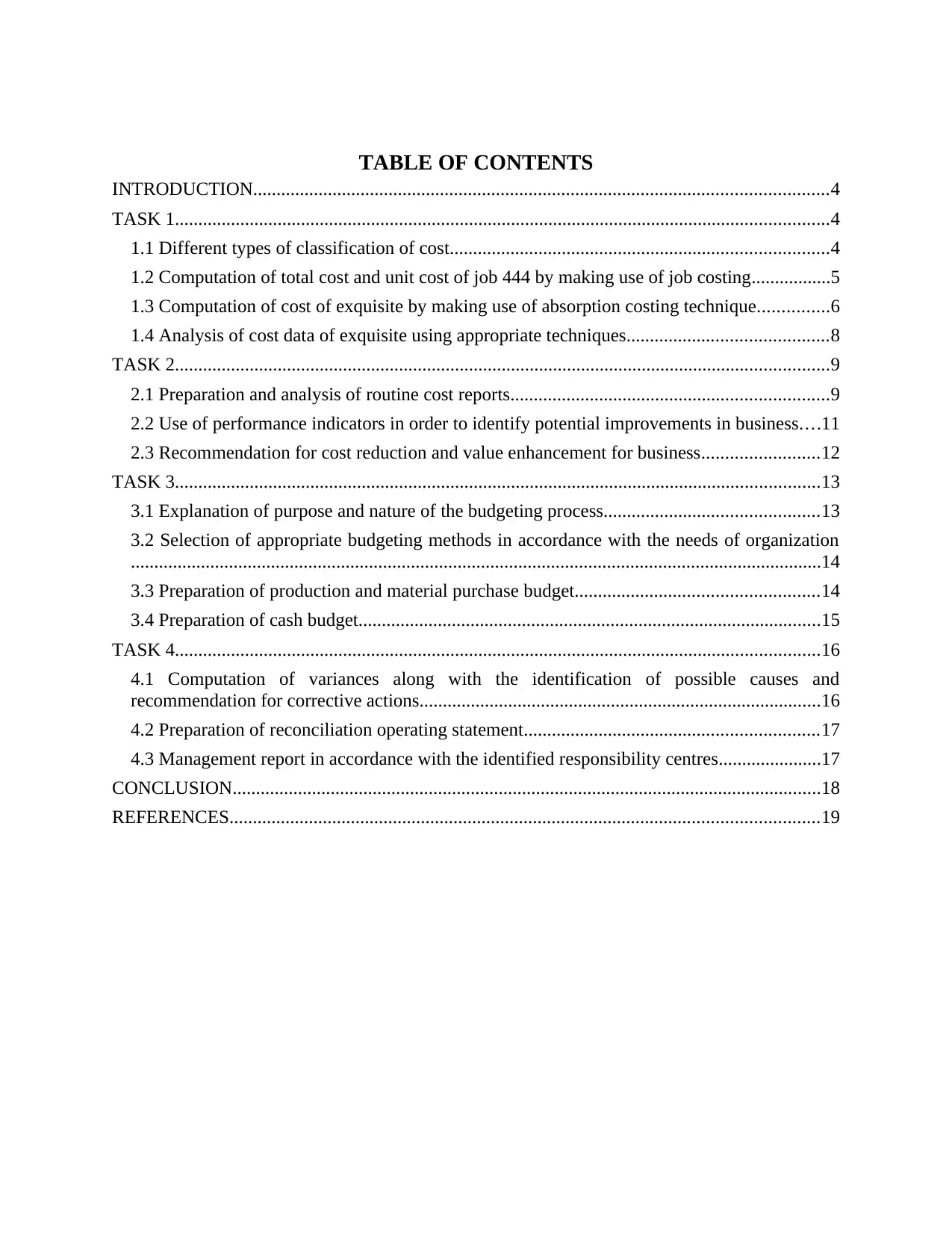
TABLE OF CONTENTS
INTRODUCTION...........................................................................................................................4
TASK 1............................................................................................................................................4
1.1 Different types of classification of cost.................................................................................4
1.2 Computation of total cost and unit cost of job 444 by making use of job costing.................5
1.3 Computation of cost of exquisite by making use of absorption costing technique...............6
1.4 Analysis of cost data of exquisite using appropriate techniques...........................................8
TASK 2............................................................................................................................................9
2.1 Preparation and analysis of routine cost reports....................................................................9
2.2 Use of performance indicators in order to identify potential improvements in business....11
2.3 Recommendation for cost reduction and value enhancement for business.........................12
TASK 3..........................................................................................................................................13
3.1 Explanation of purpose and nature of the budgeting process..............................................13
3.2 Selection of appropriate budgeting methods in accordance with the needs of organization
....................................................................................................................................................14
3.3 Preparation of production and material purchase budget....................................................14
3.4 Preparation of cash budget...................................................................................................15
TASK 4..........................................................................................................................................16
4.1 Computation of variances along with the identification of possible causes and
recommendation for corrective actions......................................................................................16
4.2 Preparation of reconciliation operating statement...............................................................17
4.3 Management report in accordance with the identified responsibility centres......................17
CONCLUSION..............................................................................................................................18
REFERENCES..............................................................................................................................19
INTRODUCTION...........................................................................................................................4
TASK 1............................................................................................................................................4
1.1 Different types of classification of cost.................................................................................4
1.2 Computation of total cost and unit cost of job 444 by making use of job costing.................5
1.3 Computation of cost of exquisite by making use of absorption costing technique...............6
1.4 Analysis of cost data of exquisite using appropriate techniques...........................................8
TASK 2............................................................................................................................................9
2.1 Preparation and analysis of routine cost reports....................................................................9
2.2 Use of performance indicators in order to identify potential improvements in business....11
2.3 Recommendation for cost reduction and value enhancement for business.........................12
TASK 3..........................................................................................................................................13
3.1 Explanation of purpose and nature of the budgeting process..............................................13
3.2 Selection of appropriate budgeting methods in accordance with the needs of organization
....................................................................................................................................................14
3.3 Preparation of production and material purchase budget....................................................14
3.4 Preparation of cash budget...................................................................................................15
TASK 4..........................................................................................................................................16
4.1 Computation of variances along with the identification of possible causes and
recommendation for corrective actions......................................................................................16
4.2 Preparation of reconciliation operating statement...............................................................17
4.3 Management report in accordance with the identified responsibility centres......................17
CONCLUSION..............................................................................................................................18
REFERENCES..............................................................................................................................19
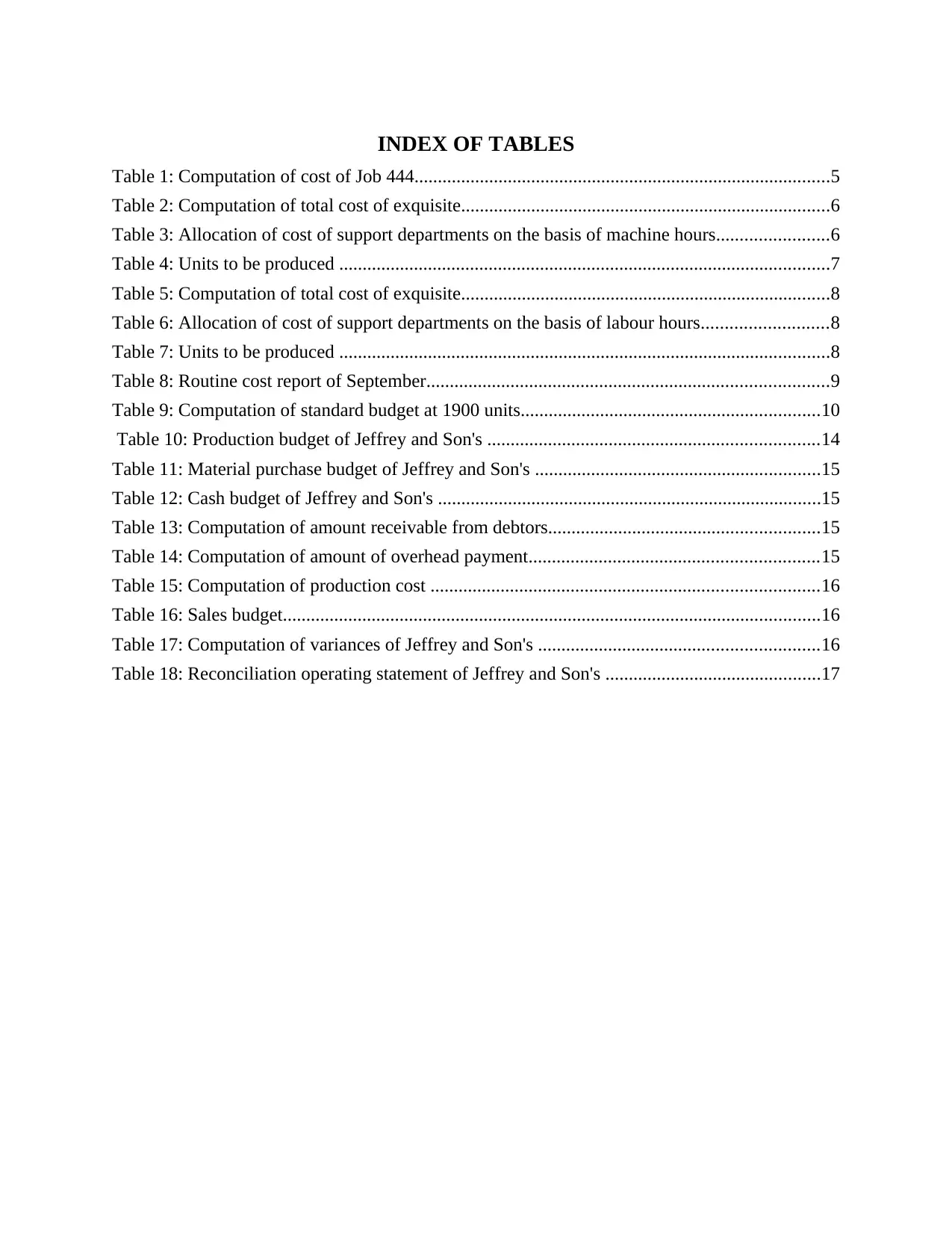
INDEX OF TABLES
Table 1: Computation of cost of Job 444.........................................................................................5
Table 2: Computation of total cost of exquisite...............................................................................6
Table 3: Allocation of cost of support departments on the basis of machine hours........................6
Table 4: Units to be produced .........................................................................................................7
Table 5: Computation of total cost of exquisite...............................................................................8
Table 6: Allocation of cost of support departments on the basis of labour hours...........................8
Table 7: Units to be produced .........................................................................................................8
Table 8: Routine cost report of September......................................................................................9
Table 9: Computation of standard budget at 1900 units................................................................10
Table 10: Production budget of Jeffrey and Son's .......................................................................14
Table 11: Material purchase budget of Jeffrey and Son's .............................................................15
Table 12: Cash budget of Jeffrey and Son's ..................................................................................15
Table 13: Computation of amount receivable from debtors..........................................................15
Table 14: Computation of amount of overhead payment..............................................................15
Table 15: Computation of production cost ...................................................................................16
Table 16: Sales budget...................................................................................................................16
Table 17: Computation of variances of Jeffrey and Son's ............................................................16
Table 18: Reconciliation operating statement of Jeffrey and Son's ..............................................17
Table 1: Computation of cost of Job 444.........................................................................................5
Table 2: Computation of total cost of exquisite...............................................................................6
Table 3: Allocation of cost of support departments on the basis of machine hours........................6
Table 4: Units to be produced .........................................................................................................7
Table 5: Computation of total cost of exquisite...............................................................................8
Table 6: Allocation of cost of support departments on the basis of labour hours...........................8
Table 7: Units to be produced .........................................................................................................8
Table 8: Routine cost report of September......................................................................................9
Table 9: Computation of standard budget at 1900 units................................................................10
Table 10: Production budget of Jeffrey and Son's .......................................................................14
Table 11: Material purchase budget of Jeffrey and Son's .............................................................15
Table 12: Cash budget of Jeffrey and Son's ..................................................................................15
Table 13: Computation of amount receivable from debtors..........................................................15
Table 14: Computation of amount of overhead payment..............................................................15
Table 15: Computation of production cost ...................................................................................16
Table 16: Sales budget...................................................................................................................16
Table 17: Computation of variances of Jeffrey and Son's ............................................................16
Table 18: Reconciliation operating statement of Jeffrey and Son's ..............................................17
⊘ This is a preview!⊘
Do you want full access?
Subscribe today to unlock all pages.

Trusted by 1+ million students worldwide
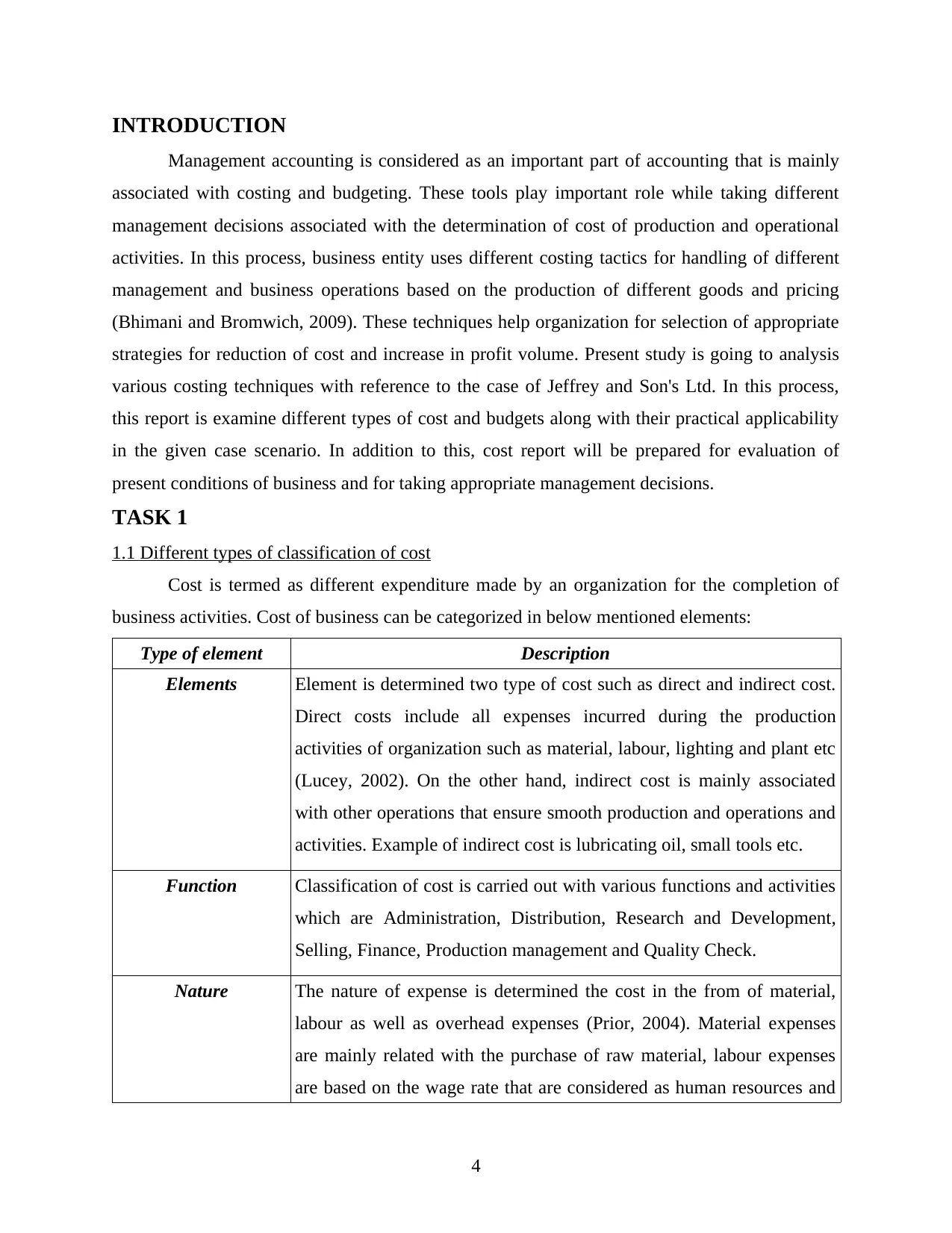
INTRODUCTION
Management accounting is considered as an important part of accounting that is mainly
associated with costing and budgeting. These tools play important role while taking different
management decisions associated with the determination of cost of production and operational
activities. In this process, business entity uses different costing tactics for handling of different
management and business operations based on the production of different goods and pricing
(Bhimani and Bromwich, 2009). These techniques help organization for selection of appropriate
strategies for reduction of cost and increase in profit volume. Present study is going to analysis
various costing techniques with reference to the case of Jeffrey and Son's Ltd. In this process,
this report is examine different types of cost and budgets along with their practical applicability
in the given case scenario. In addition to this, cost report will be prepared for evaluation of
present conditions of business and for taking appropriate management decisions.
TASK 1
1.1 Different types of classification of cost
Cost is termed as different expenditure made by an organization for the completion of
business activities. Cost of business can be categorized in below mentioned elements:
Type of element Description
Elements Element is determined two type of cost such as direct and indirect cost.
Direct costs include all expenses incurred during the production
activities of organization such as material, labour, lighting and plant etc
(Lucey, 2002). On the other hand, indirect cost is mainly associated
with other operations that ensure smooth production and operations and
activities. Example of indirect cost is lubricating oil, small tools etc.
Function Classification of cost is carried out with various functions and activities
which are Administration, Distribution, Research and Development,
Selling, Finance, Production management and Quality Check.
Nature The nature of expense is determined the cost in the from of material,
labour as well as overhead expenses (Prior, 2004). Material expenses
are mainly related with the purchase of raw material, labour expenses
are based on the wage rate that are considered as human resources and
4
Management accounting is considered as an important part of accounting that is mainly
associated with costing and budgeting. These tools play important role while taking different
management decisions associated with the determination of cost of production and operational
activities. In this process, business entity uses different costing tactics for handling of different
management and business operations based on the production of different goods and pricing
(Bhimani and Bromwich, 2009). These techniques help organization for selection of appropriate
strategies for reduction of cost and increase in profit volume. Present study is going to analysis
various costing techniques with reference to the case of Jeffrey and Son's Ltd. In this process,
this report is examine different types of cost and budgets along with their practical applicability
in the given case scenario. In addition to this, cost report will be prepared for evaluation of
present conditions of business and for taking appropriate management decisions.
TASK 1
1.1 Different types of classification of cost
Cost is termed as different expenditure made by an organization for the completion of
business activities. Cost of business can be categorized in below mentioned elements:
Type of element Description
Elements Element is determined two type of cost such as direct and indirect cost.
Direct costs include all expenses incurred during the production
activities of organization such as material, labour, lighting and plant etc
(Lucey, 2002). On the other hand, indirect cost is mainly associated
with other operations that ensure smooth production and operations and
activities. Example of indirect cost is lubricating oil, small tools etc.
Function Classification of cost is carried out with various functions and activities
which are Administration, Distribution, Research and Development,
Selling, Finance, Production management and Quality Check.
Nature The nature of expense is determined the cost in the from of material,
labour as well as overhead expenses (Prior, 2004). Material expenses
are mainly related with the purchase of raw material, labour expenses
are based on the wage rate that are considered as human resources and
4
Paraphrase This Document
Need a fresh take? Get an instant paraphrase of this document with our AI Paraphraser
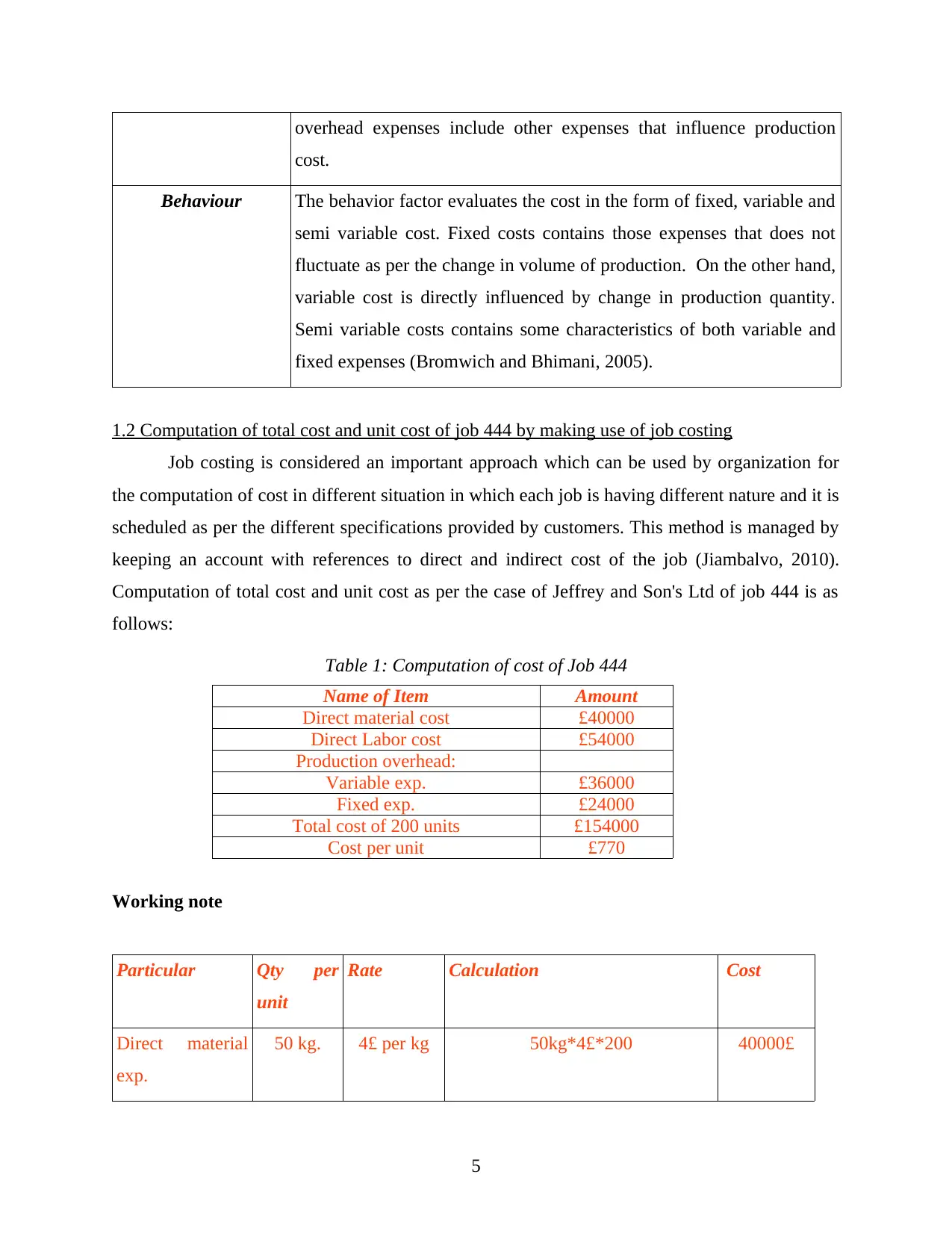
overhead expenses include other expenses that influence production
cost.
Behaviour The behavior factor evaluates the cost in the form of fixed, variable and
semi variable cost. Fixed costs contains those expenses that does not
fluctuate as per the change in volume of production. On the other hand,
variable cost is directly influenced by change in production quantity.
Semi variable costs contains some characteristics of both variable and
fixed expenses (Bromwich and Bhimani, 2005).
1.2 Computation of total cost and unit cost of job 444 by making use of job costing
Job costing is considered an important approach which can be used by organization for
the computation of cost in different situation in which each job is having different nature and it is
scheduled as per the different specifications provided by customers. This method is managed by
keeping an account with references to direct and indirect cost of the job (Jiambalvo, 2010).
Computation of total cost and unit cost as per the case of Jeffrey and Son's Ltd of job 444 is as
follows:
Table 1: Computation of cost of Job 444
Name of Item Amount
Direct material cost £40000
Direct Labor cost £54000
Production overhead:
Variable exp. £36000
Fixed exp. £24000
Total cost of 200 units £154000
Cost per unit £770
Working note
Particular Qty per
unit
Rate Calculation Cost
Direct material
exp.
50 kg. 4£ per kg 50kg*4£*200 40000£
5
cost.
Behaviour The behavior factor evaluates the cost in the form of fixed, variable and
semi variable cost. Fixed costs contains those expenses that does not
fluctuate as per the change in volume of production. On the other hand,
variable cost is directly influenced by change in production quantity.
Semi variable costs contains some characteristics of both variable and
fixed expenses (Bromwich and Bhimani, 2005).
1.2 Computation of total cost and unit cost of job 444 by making use of job costing
Job costing is considered an important approach which can be used by organization for
the computation of cost in different situation in which each job is having different nature and it is
scheduled as per the different specifications provided by customers. This method is managed by
keeping an account with references to direct and indirect cost of the job (Jiambalvo, 2010).
Computation of total cost and unit cost as per the case of Jeffrey and Son's Ltd of job 444 is as
follows:
Table 1: Computation of cost of Job 444
Name of Item Amount
Direct material cost £40000
Direct Labor cost £54000
Production overhead:
Variable exp. £36000
Fixed exp. £24000
Total cost of 200 units £154000
Cost per unit £770
Working note
Particular Qty per
unit
Rate Calculation Cost
Direct material
exp.
50 kg. 4£ per kg 50kg*4£*200 40000£
5
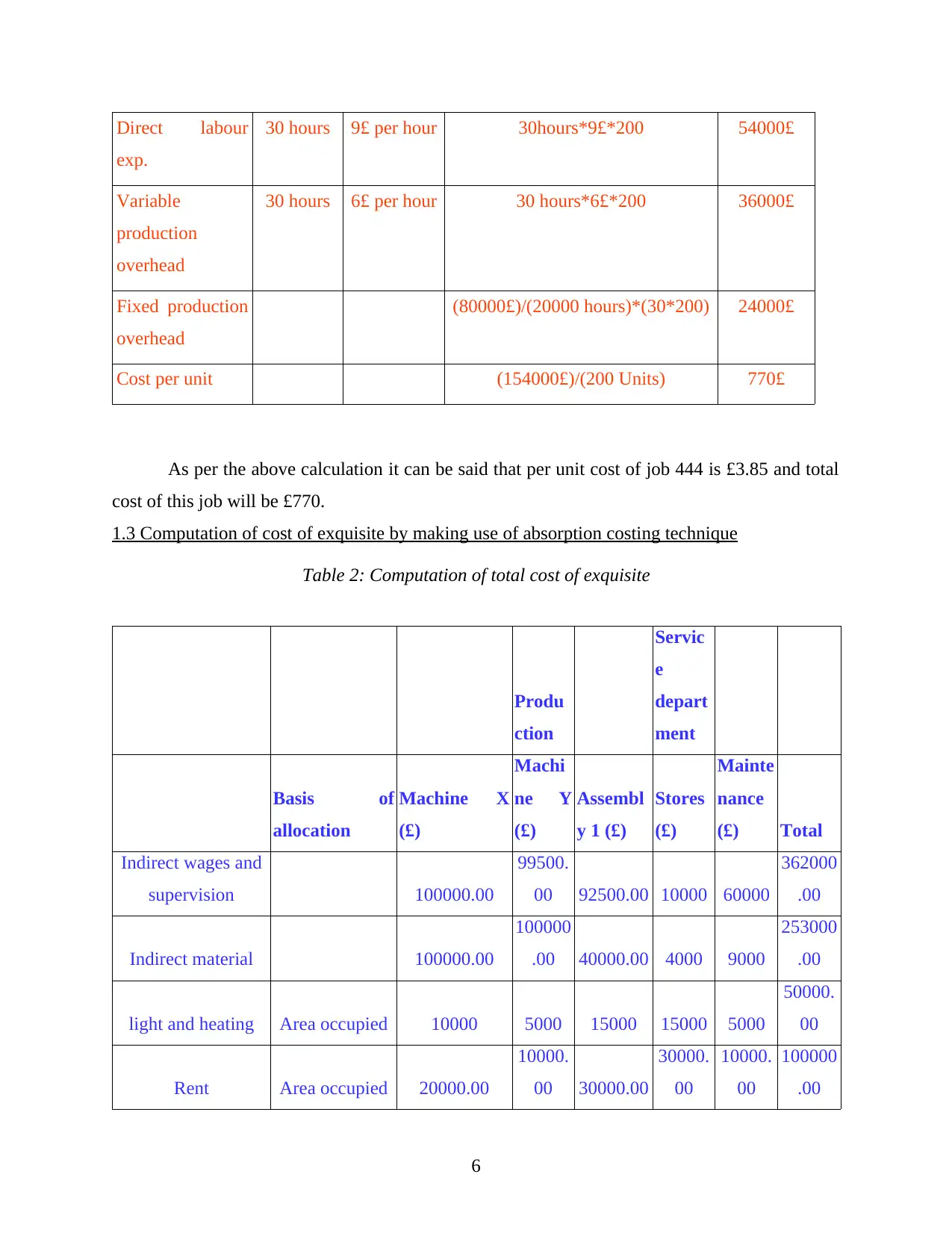
Direct labour
exp.
30 hours 9£ per hour 30hours*9£*200 54000£
Variable
production
overhead
30 hours 6£ per hour 30 hours*6£*200 36000£
Fixed production
overhead
(80000£)/(20000 hours)*(30*200) 24000£
Cost per unit (154000£)/(200 Units) 770£
As per the above calculation it can be said that per unit cost of job 444 is £3.85 and total
cost of this job will be £770.
1.3 Computation of cost of exquisite by making use of absorption costing technique
Table 2: Computation of total cost of exquisite
Produ
ction
Servic
e
depart
ment
Basis of
allocation
Machine X
(£)
Machi
ne Y
(£)
Assembl
y 1 (£)
Stores
(£)
Mainte
nance
(£) Total
Indirect wages and
supervision 100000.00
99500.
00 92500.00 10000 60000
362000
.00
Indirect material 100000.00
100000
.00 40000.00 4000 9000
253000
.00
light and heating Area occupied 10000 5000 15000 15000 5000
50000.
00
Rent Area occupied 20000.00
10000.
00 30000.00
30000.
00
10000.
00
100000
.00
6
exp.
30 hours 9£ per hour 30hours*9£*200 54000£
Variable
production
overhead
30 hours 6£ per hour 30 hours*6£*200 36000£
Fixed production
overhead
(80000£)/(20000 hours)*(30*200) 24000£
Cost per unit (154000£)/(200 Units) 770£
As per the above calculation it can be said that per unit cost of job 444 is £3.85 and total
cost of this job will be £770.
1.3 Computation of cost of exquisite by making use of absorption costing technique
Table 2: Computation of total cost of exquisite
Produ
ction
Servic
e
depart
ment
Basis of
allocation
Machine X
(£)
Machi
ne Y
(£)
Assembl
y 1 (£)
Stores
(£)
Mainte
nance
(£) Total
Indirect wages and
supervision 100000.00
99500.
00 92500.00 10000 60000
362000
.00
Indirect material 100000.00
100000
.00 40000.00 4000 9000
253000
.00
light and heating Area occupied 10000 5000 15000 15000 5000
50000.
00
Rent Area occupied 20000.00
10000.
00 30000.00
30000.
00
10000.
00
100000
.00
6
⊘ This is a preview!⊘
Do you want full access?
Subscribe today to unlock all pages.

Trusted by 1+ million students worldwide
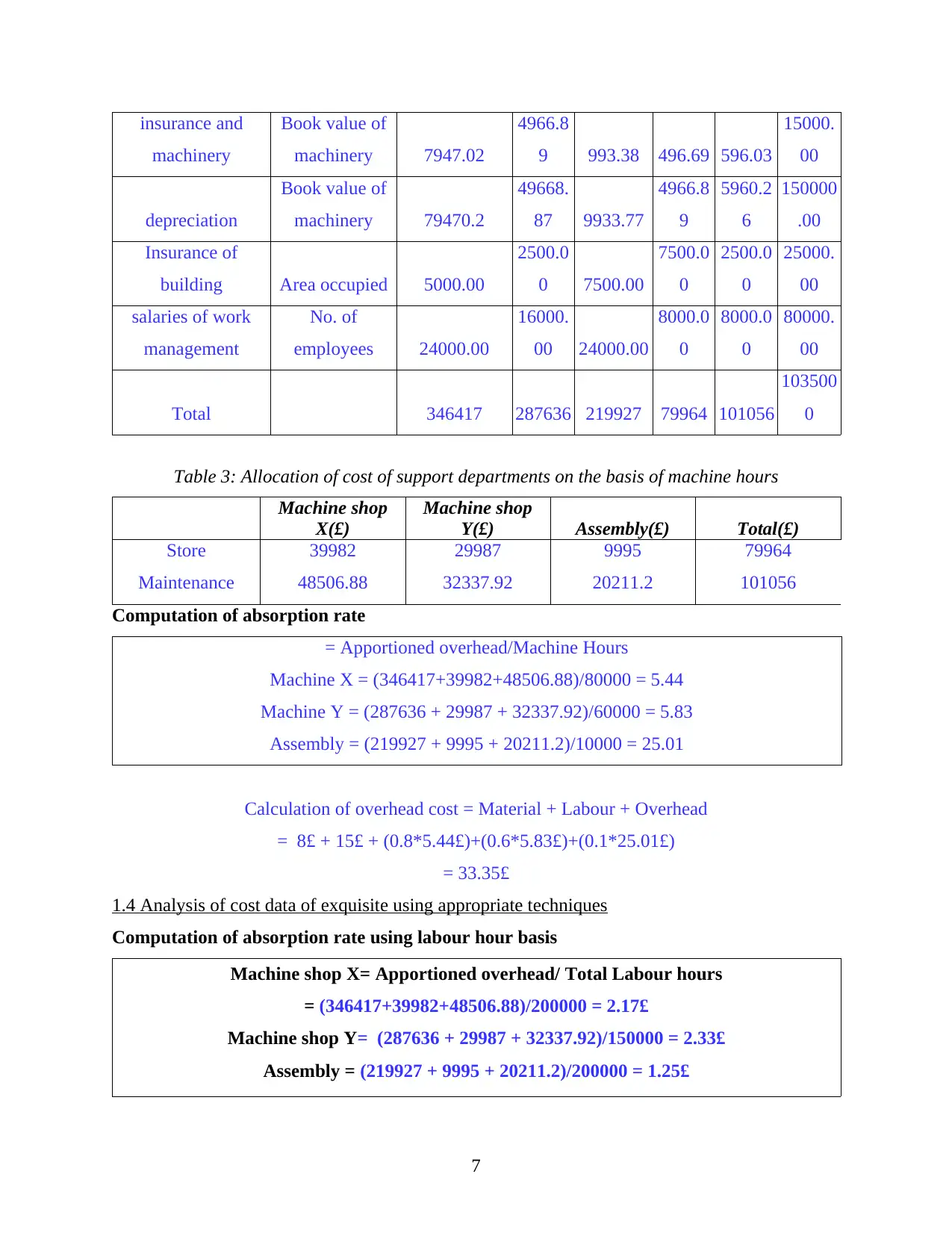
insurance and
machinery
Book value of
machinery 7947.02
4966.8
9 993.38 496.69 596.03
15000.
00
depreciation
Book value of
machinery 79470.2
49668.
87 9933.77
4966.8
9
5960.2
6
150000
.00
Insurance of
building Area occupied 5000.00
2500.0
0 7500.00
7500.0
0
2500.0
0
25000.
00
salaries of work
management
No. of
employees 24000.00
16000.
00 24000.00
8000.0
0
8000.0
0
80000.
00
Total 346417 287636 219927 79964 101056
103500
0
Table 3: Allocation of cost of support departments on the basis of machine hours
Machine shop
X(£)
Machine shop
Y(£) Assembly(£) Total(£)
Store 39982 29987 9995 79964
Maintenance 48506.88 32337.92 20211.2 101056
Computation of absorption rate
= Apportioned overhead/Machine Hours
Machine X = (346417+39982+48506.88)/80000 = 5.44
Machine Y = (287636 + 29987 + 32337.92)/60000 = 5.83
Assembly = (219927 + 9995 + 20211.2)/10000 = 25.01
Calculation of overhead cost = Material + Labour + Overhead
= 8£ + 15£ + (0.8*5.44£)+(0.6*5.83£)+(0.1*25.01£)
= 33.35£
1.4 Analysis of cost data of exquisite using appropriate techniques
Computation of absorption rate using labour hour basis
Machine shop X= Apportioned overhead/ Total Labour hours
= (346417+39982+48506.88)/200000 = 2.17£
Machine shop Y= (287636 + 29987 + 32337.92)/150000 = 2.33£
Assembly = (219927 + 9995 + 20211.2)/200000 = 1.25£
7
machinery
Book value of
machinery 7947.02
4966.8
9 993.38 496.69 596.03
15000.
00
depreciation
Book value of
machinery 79470.2
49668.
87 9933.77
4966.8
9
5960.2
6
150000
.00
Insurance of
building Area occupied 5000.00
2500.0
0 7500.00
7500.0
0
2500.0
0
25000.
00
salaries of work
management
No. of
employees 24000.00
16000.
00 24000.00
8000.0
0
8000.0
0
80000.
00
Total 346417 287636 219927 79964 101056
103500
0
Table 3: Allocation of cost of support departments on the basis of machine hours
Machine shop
X(£)
Machine shop
Y(£) Assembly(£) Total(£)
Store 39982 29987 9995 79964
Maintenance 48506.88 32337.92 20211.2 101056
Computation of absorption rate
= Apportioned overhead/Machine Hours
Machine X = (346417+39982+48506.88)/80000 = 5.44
Machine Y = (287636 + 29987 + 32337.92)/60000 = 5.83
Assembly = (219927 + 9995 + 20211.2)/10000 = 25.01
Calculation of overhead cost = Material + Labour + Overhead
= 8£ + 15£ + (0.8*5.44£)+(0.6*5.83£)+(0.1*25.01£)
= 33.35£
1.4 Analysis of cost data of exquisite using appropriate techniques
Computation of absorption rate using labour hour basis
Machine shop X= Apportioned overhead/ Total Labour hours
= (346417+39982+48506.88)/200000 = 2.17£
Machine shop Y= (287636 + 29987 + 32337.92)/150000 = 2.33£
Assembly = (219927 + 9995 + 20211.2)/200000 = 1.25£
7
Paraphrase This Document
Need a fresh take? Get an instant paraphrase of this document with our AI Paraphraser

Total cost of product = Material + Labour + overhead
= 8£ + 15£ +(2*2.17) + (1.5*2.33) + (1*1.25) = 32.09
By applying change in absorption rate from machine hour to labour hour, there has been
drastic change addressed in per unit absorption rate. By considering the norms of costing
standards, absorption from labour hours is termed as a better method.
TASK 2
2.1 Preparation and analysis of routine cost reports
Table 4: Routine cost report of September
Budgeted cost Actual cost Variances
Particulars
Units 2000 units 1900 units
Material cost £24000 £22800 £-1200
Labor cost £18000 £19000 £1000
Fixed overhead £15000 £15000 -
Prime cost £57000 £56800 -
Electricity
Fixed portion £500 £500 -
Variable portion £7500 £7125 £375
Maintenance £5000 £5000 -
Total production cost £70000 £69425
Working notes
Table 5: Computation of standard budget at 1900 units
Budgeted cost Budgeted cost
Particulars
Units 2000 units 1900 units
Material cost £24000 £22800
Labor cost £18000 £17100
Fixed overhead £15000 £15000
Prime cost £57000 £54900
Electricity
Fixed portion £500 £500
Variable portion £7500 £7125
Maintenance £5000 £5000
Total production cost £70000 £67525
Computation of variable cost - Electricity
=Change in total cost / Change in no. of units to be produced
=(8000-5000)/(2000-1200)
8
= 8£ + 15£ +(2*2.17) + (1.5*2.33) + (1*1.25) = 32.09
By applying change in absorption rate from machine hour to labour hour, there has been
drastic change addressed in per unit absorption rate. By considering the norms of costing
standards, absorption from labour hours is termed as a better method.
TASK 2
2.1 Preparation and analysis of routine cost reports
Table 4: Routine cost report of September
Budgeted cost Actual cost Variances
Particulars
Units 2000 units 1900 units
Material cost £24000 £22800 £-1200
Labor cost £18000 £19000 £1000
Fixed overhead £15000 £15000 -
Prime cost £57000 £56800 -
Electricity
Fixed portion £500 £500 -
Variable portion £7500 £7125 £375
Maintenance £5000 £5000 -
Total production cost £70000 £69425
Working notes
Table 5: Computation of standard budget at 1900 units
Budgeted cost Budgeted cost
Particulars
Units 2000 units 1900 units
Material cost £24000 £22800
Labor cost £18000 £17100
Fixed overhead £15000 £15000
Prime cost £57000 £54900
Electricity
Fixed portion £500 £500
Variable portion £7500 £7125
Maintenance £5000 £5000
Total production cost £70000 £67525
Computation of variable cost - Electricity
=Change in total cost / Change in no. of units to be produced
=(8000-5000)/(2000-1200)
8
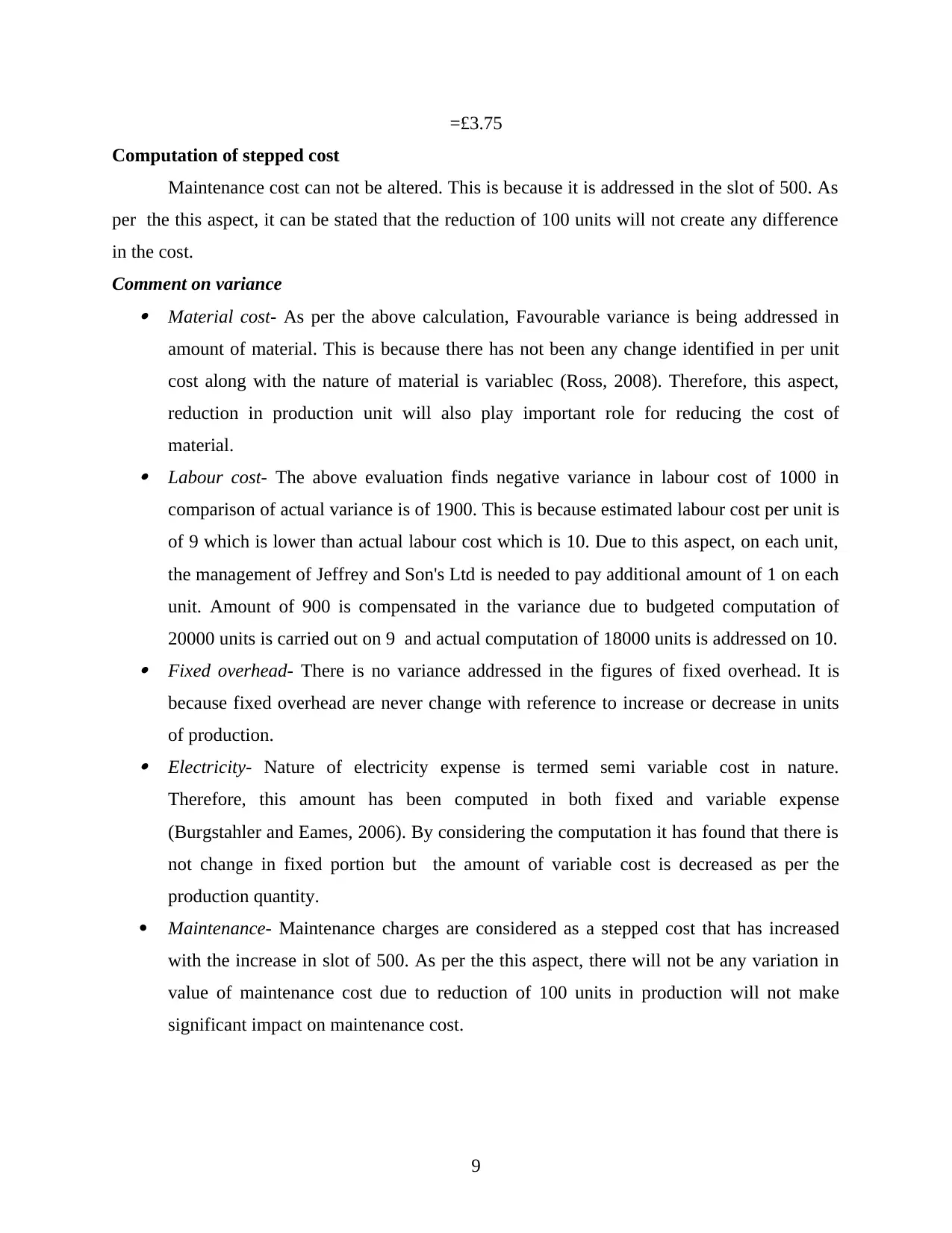
=£3.75
Computation of stepped cost
Maintenance cost can not be altered. This is because it is addressed in the slot of 500. As
per the this aspect, it can be stated that the reduction of 100 units will not create any difference
in the cost.
Comment on variance Material cost- As per the above calculation, Favourable variance is being addressed in
amount of material. This is because there has not been any change identified in per unit
cost along with the nature of material is variablec (Ross, 2008). Therefore, this aspect,
reduction in production unit will also play important role for reducing the cost of
material. Labour cost- The above evaluation finds negative variance in labour cost of 1000 in
comparison of actual variance is of 1900. This is because estimated labour cost per unit is
of 9 which is lower than actual labour cost which is 10. Due to this aspect, on each unit,
the management of Jeffrey and Son's Ltd is needed to pay additional amount of 1 on each
unit. Amount of 900 is compensated in the variance due to budgeted computation of
20000 units is carried out on 9 and actual computation of 18000 units is addressed on 10. Fixed overhead- There is no variance addressed in the figures of fixed overhead. It is
because fixed overhead are never change with reference to increase or decrease in units
of production. Electricity- Nature of electricity expense is termed semi variable cost in nature.
Therefore, this amount has been computed in both fixed and variable expense
(Burgstahler and Eames, 2006). By considering the computation it has found that there is
not change in fixed portion but the amount of variable cost is decreased as per the
production quantity.
Maintenance- Maintenance charges are considered as a stepped cost that has increased
with the increase in slot of 500. As per the this aspect, there will not be any variation in
value of maintenance cost due to reduction of 100 units in production will not make
significant impact on maintenance cost.
9
Computation of stepped cost
Maintenance cost can not be altered. This is because it is addressed in the slot of 500. As
per the this aspect, it can be stated that the reduction of 100 units will not create any difference
in the cost.
Comment on variance Material cost- As per the above calculation, Favourable variance is being addressed in
amount of material. This is because there has not been any change identified in per unit
cost along with the nature of material is variablec (Ross, 2008). Therefore, this aspect,
reduction in production unit will also play important role for reducing the cost of
material. Labour cost- The above evaluation finds negative variance in labour cost of 1000 in
comparison of actual variance is of 1900. This is because estimated labour cost per unit is
of 9 which is lower than actual labour cost which is 10. Due to this aspect, on each unit,
the management of Jeffrey and Son's Ltd is needed to pay additional amount of 1 on each
unit. Amount of 900 is compensated in the variance due to budgeted computation of
20000 units is carried out on 9 and actual computation of 18000 units is addressed on 10. Fixed overhead- There is no variance addressed in the figures of fixed overhead. It is
because fixed overhead are never change with reference to increase or decrease in units
of production. Electricity- Nature of electricity expense is termed semi variable cost in nature.
Therefore, this amount has been computed in both fixed and variable expense
(Burgstahler and Eames, 2006). By considering the computation it has found that there is
not change in fixed portion but the amount of variable cost is decreased as per the
production quantity.
Maintenance- Maintenance charges are considered as a stepped cost that has increased
with the increase in slot of 500. As per the this aspect, there will not be any variation in
value of maintenance cost due to reduction of 100 units in production will not make
significant impact on maintenance cost.
9
⊘ This is a preview!⊘
Do you want full access?
Subscribe today to unlock all pages.

Trusted by 1+ million students worldwide
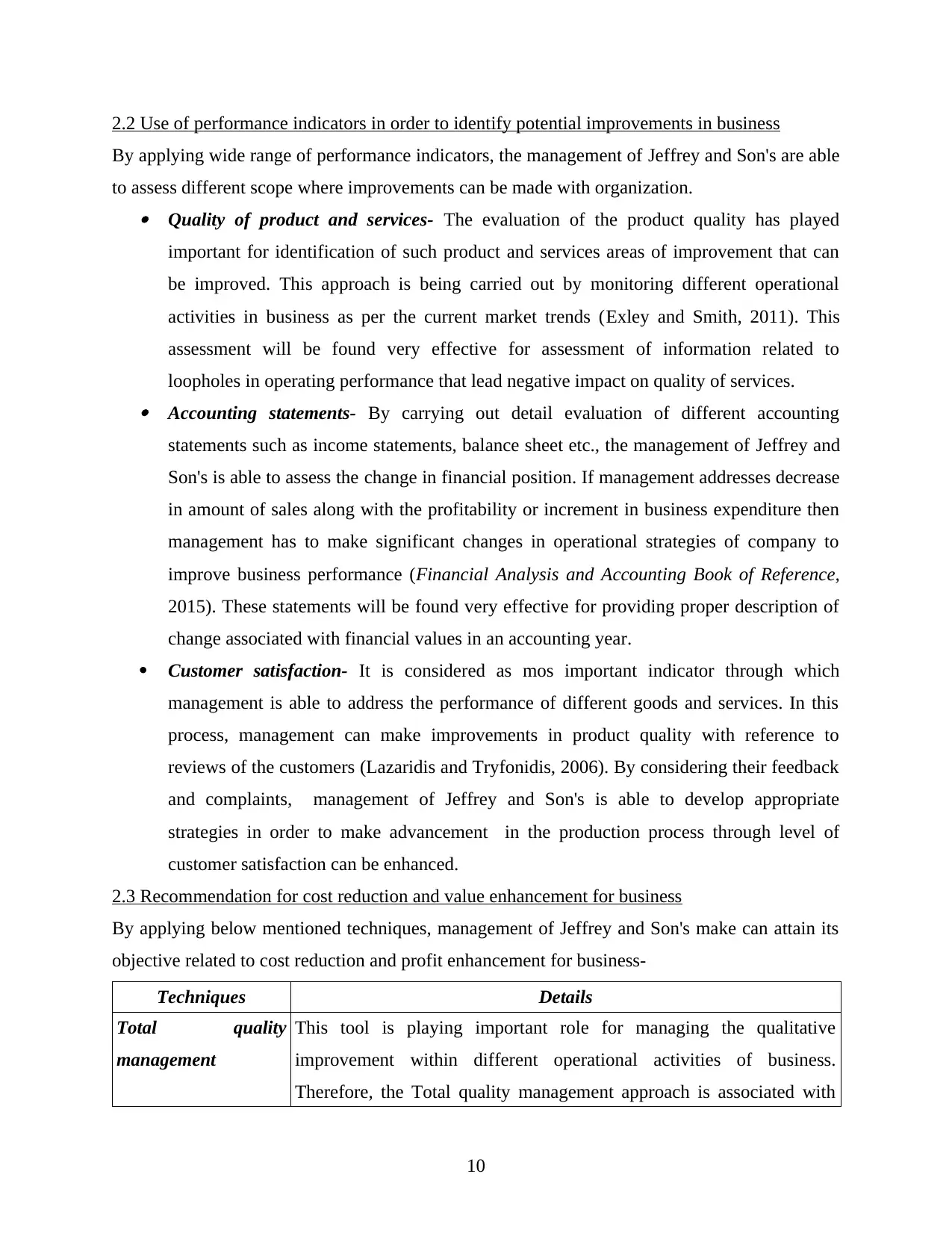
2.2 Use of performance indicators in order to identify potential improvements in business
By applying wide range of performance indicators, the management of Jeffrey and Son's are able
to assess different scope where improvements can be made with organization. Quality of product and services- The evaluation of the product quality has played
important for identification of such product and services areas of improvement that can
be improved. This approach is being carried out by monitoring different operational
activities in business as per the current market trends (Exley and Smith, 2011). This
assessment will be found very effective for assessment of information related to
loopholes in operating performance that lead negative impact on quality of services. Accounting statements- By carrying out detail evaluation of different accounting
statements such as income statements, balance sheet etc., the management of Jeffrey and
Son's is able to assess the change in financial position. If management addresses decrease
in amount of sales along with the profitability or increment in business expenditure then
management has to make significant changes in operational strategies of company to
improve business performance (Financial Analysis and Accounting Book of Reference,
2015). These statements will be found very effective for providing proper description of
change associated with financial values in an accounting year.
Customer satisfaction- It is considered as mos important indicator through which
management is able to address the performance of different goods and services. In this
process, management can make improvements in product quality with reference to
reviews of the customers (Lazaridis and Tryfonidis, 2006). By considering their feedback
and complaints, management of Jeffrey and Son's is able to develop appropriate
strategies in order to make advancement in the production process through level of
customer satisfaction can be enhanced.
2.3 Recommendation for cost reduction and value enhancement for business
By applying below mentioned techniques, management of Jeffrey and Son's make can attain its
objective related to cost reduction and profit enhancement for business-
Techniques Details
Total quality
management
This tool is playing important role for managing the qualitative
improvement within different operational activities of business.
Therefore, the Total quality management approach is associated with
10
By applying wide range of performance indicators, the management of Jeffrey and Son's are able
to assess different scope where improvements can be made with organization. Quality of product and services- The evaluation of the product quality has played
important for identification of such product and services areas of improvement that can
be improved. This approach is being carried out by monitoring different operational
activities in business as per the current market trends (Exley and Smith, 2011). This
assessment will be found very effective for assessment of information related to
loopholes in operating performance that lead negative impact on quality of services. Accounting statements- By carrying out detail evaluation of different accounting
statements such as income statements, balance sheet etc., the management of Jeffrey and
Son's is able to assess the change in financial position. If management addresses decrease
in amount of sales along with the profitability or increment in business expenditure then
management has to make significant changes in operational strategies of company to
improve business performance (Financial Analysis and Accounting Book of Reference,
2015). These statements will be found very effective for providing proper description of
change associated with financial values in an accounting year.
Customer satisfaction- It is considered as mos important indicator through which
management is able to address the performance of different goods and services. In this
process, management can make improvements in product quality with reference to
reviews of the customers (Lazaridis and Tryfonidis, 2006). By considering their feedback
and complaints, management of Jeffrey and Son's is able to develop appropriate
strategies in order to make advancement in the production process through level of
customer satisfaction can be enhanced.
2.3 Recommendation for cost reduction and value enhancement for business
By applying below mentioned techniques, management of Jeffrey and Son's make can attain its
objective related to cost reduction and profit enhancement for business-
Techniques Details
Total quality
management
This tool is playing important role for managing the qualitative
improvement within different operational activities of business.
Therefore, the Total quality management approach is associated with
10
Paraphrase This Document
Need a fresh take? Get an instant paraphrase of this document with our AI Paraphraser

the improvement in overall production process by evaluating and
resolving different deviations in the production process (Wahlen and
et.al., 2011). This system assists Jeffrey and Son's for improving
overall efficiency of company.
Kaizen costing Similar to the TQM approach, Kaizen costing is paid extra attention on
continuous betterment in the whole business functioning of the firm.
This technique has found very effective in order to motivate employees
for accomplishment of operational tasks with with an appropriate
manner (Gitman, Juchau and Flanagan, 2010). It supports management
for reducing wastage of resources by considering below mentioned
factors:
▪ High waiting time
▪ Inappropriate allocation of human resources
▪ Production quantity is higher than requirement
▪ Increase in faulty production units
▪ Improper inventory management
Just in time system
and economic order
quantity
The system helps managers of organization in reduction of storage and
carrying cost of different inventories. As per this approach,
management of Jeffrey and Son's will manage the purchase of raw
material per the demand of final product in the market (Litzenberger
and Jones, 2012). This technique plays significant role in order to
reduce unwanted inventory of business.
TASK 3
3.1 Explanation of purpose and nature of the budgeting process
Purpose of budgeting process
Budgets is termed as an important statements which is prepared for the forecasting of
future operational activities as per the goals of company. As per the case of Jeffrey and Son's, the
primary objective of budgeting process is to carry out a systematic estimation of future expenses
and revenue through which management of Jeffrey and Son'sis able to allocate resources in an
11
resolving different deviations in the production process (Wahlen and
et.al., 2011). This system assists Jeffrey and Son's for improving
overall efficiency of company.
Kaizen costing Similar to the TQM approach, Kaizen costing is paid extra attention on
continuous betterment in the whole business functioning of the firm.
This technique has found very effective in order to motivate employees
for accomplishment of operational tasks with with an appropriate
manner (Gitman, Juchau and Flanagan, 2010). It supports management
for reducing wastage of resources by considering below mentioned
factors:
▪ High waiting time
▪ Inappropriate allocation of human resources
▪ Production quantity is higher than requirement
▪ Increase in faulty production units
▪ Improper inventory management
Just in time system
and economic order
quantity
The system helps managers of organization in reduction of storage and
carrying cost of different inventories. As per this approach,
management of Jeffrey and Son's will manage the purchase of raw
material per the demand of final product in the market (Litzenberger
and Jones, 2012). This technique plays significant role in order to
reduce unwanted inventory of business.
TASK 3
3.1 Explanation of purpose and nature of the budgeting process
Purpose of budgeting process
Budgets is termed as an important statements which is prepared for the forecasting of
future operational activities as per the goals of company. As per the case of Jeffrey and Son's, the
primary objective of budgeting process is to carry out a systematic estimation of future expenses
and revenue through which management of Jeffrey and Son'sis able to allocate resources in an
11

optimum manner (Hawawini and Viallet, 2010). These statements play significant role for
estimations of the future profit of business On the basis of these statements, several decisions are
taken by managerial persons. The budgeting helps managers in making comparison of actual
performance with reference to standard performance.
Nature of budgeting process
Estimation in budgetary statements is determined the by considering the actual values of
last accounting period. With this estimation, the management of Jeffrey and Son'sis able to
compute the possible amount of cash that would be generated from the sales and other activities
of business in near future so as manager avoids various financial issues. It provides information
about various business expenses such as material, labour and production expenses that assist
management of Jeffrey and Son's for taking appropriate business decisions (Scapens, 2006). The
whole budgeting process and different budgets are reviewed by senior manager and it is
submitted to the board of directors for development of various business strategies as per the
budget.
3.2 Selection of appropriate budgeting methods in accordance with the needs of organization
Preparation of budgets is carried out by considering different methods as per the distinct
needs and requirements of different commercial entity. Description of various budgeting
approaches is determined in below mentioned statement: Zero based budgeting- This method of budget is considered by an organisation in
situation in which there is not any previous base for preparation of budget. This situation
is occurred due to drastic change in market situations or company wants to develop new
product. In this technique, there are no measures of forecasted therefore there is high
possibility of variances and deviations. Operational budgets- These kinds of budgets are prepared by considering separate
operational activities which are related to production, selling, marketing as well as
distribution etc (Management accounting, 2014). These budgets are developed periodical
basis that can be annual, monthly or quarterly in which management consider the short
term and long term goals of company. On the basis of these budgets, management
implements several business strategies for attainment of short term and long term goals.
Incremental budgeting- This method is applied for the computation of budget in
particular situation when there are some minor changes addressed in environment
12
estimations of the future profit of business On the basis of these statements, several decisions are
taken by managerial persons. The budgeting helps managers in making comparison of actual
performance with reference to standard performance.
Nature of budgeting process
Estimation in budgetary statements is determined the by considering the actual values of
last accounting period. With this estimation, the management of Jeffrey and Son'sis able to
compute the possible amount of cash that would be generated from the sales and other activities
of business in near future so as manager avoids various financial issues. It provides information
about various business expenses such as material, labour and production expenses that assist
management of Jeffrey and Son's for taking appropriate business decisions (Scapens, 2006). The
whole budgeting process and different budgets are reviewed by senior manager and it is
submitted to the board of directors for development of various business strategies as per the
budget.
3.2 Selection of appropriate budgeting methods in accordance with the needs of organization
Preparation of budgets is carried out by considering different methods as per the distinct
needs and requirements of different commercial entity. Description of various budgeting
approaches is determined in below mentioned statement: Zero based budgeting- This method of budget is considered by an organisation in
situation in which there is not any previous base for preparation of budget. This situation
is occurred due to drastic change in market situations or company wants to develop new
product. In this technique, there are no measures of forecasted therefore there is high
possibility of variances and deviations. Operational budgets- These kinds of budgets are prepared by considering separate
operational activities which are related to production, selling, marketing as well as
distribution etc (Management accounting, 2014). These budgets are developed periodical
basis that can be annual, monthly or quarterly in which management consider the short
term and long term goals of company. On the basis of these budgets, management
implements several business strategies for attainment of short term and long term goals.
Incremental budgeting- This method is applied for the computation of budget in
particular situation when there are some minor changes addressed in environment
12
⊘ This is a preview!⊘
Do you want full access?
Subscribe today to unlock all pages.

Trusted by 1+ million students worldwide
1 out of 18
Related Documents
Your All-in-One AI-Powered Toolkit for Academic Success.
+13062052269
info@desklib.com
Available 24*7 on WhatsApp / Email
![[object Object]](/_next/static/media/star-bottom.7253800d.svg)
Unlock your academic potential
Copyright © 2020–2025 A2Z Services. All Rights Reserved. Developed and managed by ZUCOL.





